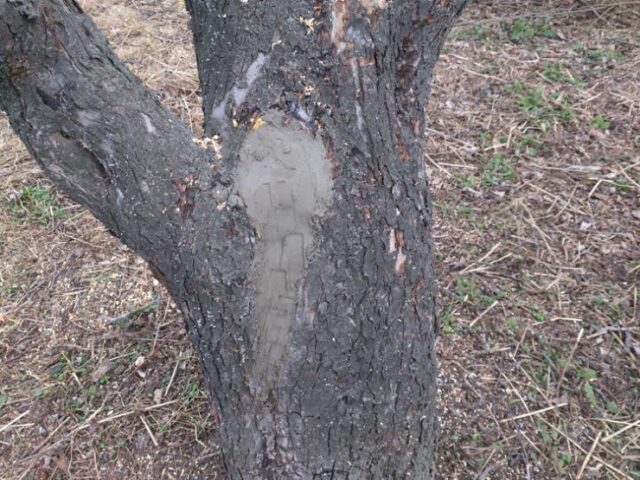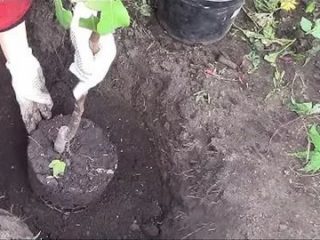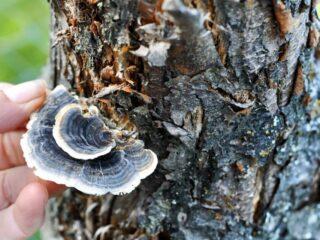Content
There are several ways to seal a hollow in an apple tree. In this case, it is necessary to take into account the condition of the cavity in the wood. If necessary, the hollow is preliminarily treated.
Causes
A hollow in the trunk of an apple tree can appear for many reasons. Most often, a hole is caused by:
- mechanical injuries to the tree - strong impacts and breakages of large branches;
- damage caused by rodents;
- frost breakers;
- lifting of bark when cutting branches incorrectly.
In most cases, cavities are the result of careless care. The wood of the apple tree cracks in the absence of shelter for the winter, when the branches are removed not “in a ring”, but leaving a stump.

A cavity in an apple tree may appear as a result of neglecting antiseptic treatment after pruning
Why is the appearance of a hollow dangerous for an apple tree?
A hollow not only spoils the appearance of the apple tree, but also causes real damage to its health. If left untreated, the hole in the trunk gradually grows, penetrates deeper and destroys the wood. As a result, the nutritional processes of the apple tree are disrupted, and the shoots of the plant begin to dry out.
If there is a hollow, the crop reduces fruiting. Untidy trees are more likely to suffer from fungi and pests and in many cases die within a few years of the hole appearing. In addition, a threat is created for neighboring fruit crops - insects and pathogenic bacteria quickly spread throughout the area.
What to do if there is a hollow growing in the trunk of an apple tree
If a hollow has formed in the apple tree, it must be repaired urgently. The fresher and cleaner the hole, the fewer problems it will cause during the filling process.
Cleaning the hole
To properly seal a small hollow in an apple tree, you first need to clean it. If infected or dead wood remains inside, repair work will have little effect. The trunk will still continue to deteriorate under a layer of putty, and eventually the apple tree will die.
The cavity is cleaned according to the following algorithm:
- Using a chisel or garden knife, remove all rotten wood.
- The first layer of healthy light tissue is also removed, since it may already contain fungal spores and bacteria.
- Difficult areas inside the hollow are scraped out with a sharpened tablespoon, illuminated with a flashlight.
- The treated cavity is cleared of all remaining small debris and wiped with a damp cloth.
- The edges of the hole are also trimmed to sound wood.
- The cavities are allowed to dry.
Infected wood and other debris must be immediately collected in a bag, removed from the site and burned.

If, when tapping the barrel, it is possible to detect a closed cavity, it must be opened and cleaned
Disinfection
The second stage of processing a hollow apple tree is high-quality disinfection. It is necessary to carry out this in order to eliminate the remnants of fungal spores and bacteria and stop further rotting.
Antiseptic treatment is performed as follows:
- Wear safety glasses, gloves and a respirator.
- Prepare a solution of copper sulfate 1-3% or a dark pink solution of potassium permanganate.
- Spray the cavity generously from the inside, trying to treat the cleaned wood as evenly as possible.
- If necessary, an additional solution of colloidal sulfur or Bordeaux mixture is used if the hole is seriously infected with fungus.
You can disinfect the hollow of a small apple tree with sorrel infusion or garden varnish. If the hole is large, you need to use strong preparations and perform treatment in several stages. At least five procedures are carried out over three weeks, the wood is allowed to dry completely, and only after that they begin filling.

To treat the hollow of an apple tree, you can use a 3% solution of carbolic acid or 5% iron sulfate.
Filling up a hollow in an apple tree
Filling the hollow in the apple tree with cement mortar or other material is the final stage of processing. Which method to choose for filling depends primarily on the size of the hole.
Cement mortar
Cement mortar is chosen for large and deep cavities. Videos about filling a hollow in an apple tree show that the process looks like this:
- The cleaned and disinfected cavity is coated from the inside with oil paint based on natural drying oil.
- A reinforcement structure made of braided wire is placed in the hole.
- Cement is mixed with sand in a ratio of 1:3 or 1:4.
- Fill the cavity with a thick solution and leave until completely dry.
After the cement has set properly, it is also treated with oil paint on top. You can match it to the color of the wood.

Cement fills the voids in the apple tree well and does not have a toxic effect on the plant.
Polyurethane foam
You can properly seal a large hollow in an apple tree using polyurethane foam. It does not allow air or moisture to pass through, so the wood inside remains reliably protected from environmental influences.
Filling is performed according to the following algorithm:
- The hole in the barrel is cleaned and disinfected.
- Wait several hours or days until the wood is completely dry.
- Treat the edges of the hollow with garden varnish.
- Seal the cavity itself with polyurethane foam and wait for it to harden.
- Cut off any remaining material around the edges of the hole.
When sealing a hollow in an apple tree with polyurethane foam, you need to take into account that the latter is very sensitive to ultraviolet radiation and is destroyed in direct sunlight. To prevent this from happening, you must immediately paint over the treated hollow with oil paint.

In order for the cavity in the trunk to heal faster, once a year after filling the hollow, its edges are cleaned down to the cambium
Treatment of a hollow in an apple tree if there are problems
Fixing an old hollow in an apple tree is more difficult than filling a fresh cavity.If the hole has been there for a long time, some problems will need to be addressed before filling it. Difficulties may arise if the hollow is large, or if there are insects or even nests inside the cavity.
How to eliminate a hollow in a seedling
Hollows in apple seedlings are quite rare. Typically, cavities in trunks appear if young trees have suffered from frost or mechanical shock.
Filling up a hollow in an apple tree with a small hole is quite easy. It is enough to simply cover the cavity with resin-based garden varnish, and wrap the area on top with polyethylene or electrical tape, the adhesive side out. Healing usually occurs quickly because the tree is actively growing and regenerating tissue without problems.
How to fill a large hollow in an apple tree
Filling a hollow in an apple tree with a large hole can be quite difficult. It is necessary to prevent moisture and air from entering the cavity, and if it is deep enough, then certain areas may still remain untreated.
Typically the problem is resolved as follows:
- The cavity is thoroughly cleaned; if necessary, a drill with a wire brush attachment is used to access remote areas.
- The hole is disinfected, not once, but three times for the best effect.
- A layer of broken brick or crushed stone is placed in the cavity, compacted and filled with cement mortar on top.
- Wait for the cork to dry.
- Lay the second layer of backfill and also fill it with cement.
- The procedure is repeated 3-6 times until the cavity is filled.
- After the last layer of cement mortar has dried, the cork is covered with garden varnish or oil paint.
If the hollow is too deep and has bends, and it is not possible to seal it using standard methods, the cavity must be expanded. To do this, healthy wood is cut out using a hand or electric tool, freeing access to the inside of the trunk, and then the usual procedures are carried out.
How to cure a hollow in an old apple tree
You can fill a hollow in an old apple tree with either cement mortar or polyurethane foam. But before carrying out the procedure, the condition of the plant should be assessed.
If the apple tree bears fruit well, the cavity in its trunk is cleaned and sealed, and then especially careful care is provided. If the tree is old, often suffers from diseases and produces a poor harvest, in many cases it is easier to cut it down than to treat it. First, you can cut healthy cuttings from the plant and graft them onto Antonovka or wild plants.
Ants in the hollow
If the hollow in the apple tree has been formed for a long time, before filling it it is necessary to check for the presence of ants. Insects often settle in cavities in the trunk, provoke the spread of aphids and increase the risk of developing fungal infections.

After filling the hollow, the tree needs to be dug in a circle and ant hunting belts should be attached to the trunks.
Before filling the hollow, it is necessary to treat the apple tree against pests with Anteater or Diazonin insecticides. To prevent insects removed from the trunk along with rotten wood from returning, they need to be poured into a bucket and poured with boiling water.
Loose wood in the hollow of an apple tree
It is more difficult to process a hollow in an apple tree if there is a lot of rotten wood inside the cavity. There are several options for solving the problem:
- If the hole is small, you can clean and treat it with fungicide, and then cover the hollow of the apple tree with clay or a mixture of ash and charcoal. A plug of healthy wood is installed on top and secured with a plastic bandage.
- For large cavity sizes, standard cleaning is carried out, and then the hole is filled with cement mortar in one or several layers. The seal is covered with garden varnish on top.
If there is a lot of rotten wood in the trunk, the damaged apple tree is simply cut down, after cutting off the stalk for subsequent grafting.
There's a nest in the hollow
Birds can build a nest in an old, large cavity in the trunk, especially if the hole is at a decent height from the ground. In this case, you can cover up the hollow in the apple tree in the fall or spring before the birds return from wintering.
The empty nest is removed from the hole and discarded, and the cavity is cleaned and treated with fungicides, and then sealed. The procedure cannot be performed at the height of summer. There may be eggs or hatched chicks in the nest at this time.
Juice flows from the hollow
Fresh sap oozing from the wood in the hollow indicates the presence of secondary diseases of the apple tree. In this case, processing is carried out as follows:
- The hole is thoroughly cleaned and treated with fungicidal preparations.
- The hollow is sealed using polyurethane foam, cement or garden varnish, depending on the size of the cavity.
- To treat the apple tree, injections are made with the drug Actellik - 2 ml of the product is dissolved in 1 liter of water and injected directly into the wood using a syringe with a thick needle.
Injections are given near the affected area. One injection is enough for 1 m2 wood The next year, to prevent diseases and pests after flowering, the apple tree is sprayed with Fufanon, stirring 10 ml of the product in a bucket of water.
Preventive measures
It is not so difficult to seal the hollow of an apple tree with foam or cement, but the appearance of cavities in the trunk in any case causes damage to the garden crop. To prevent holes from forming:
- annually clean the apple tree from overgrown moss and rotten bark in spring and autumn;
- regularly whiten the base of the trunk and skeletal branches;
- timely pruning for broken, diseased and twisted shoots;
- Use only clean, well-sharpened tools for gardening work;
- do not leave stumps after pruning the apple tree;
- immediately treat damage with garden varnish or clay mash;
- Every year, as a preventative measure, spray apple trees against fungi and pests.
To prevent hollows from appearing due to frost damage, fruit trees must be insulated for the winter. If the variety is highly sensitive to cold, you need to not only mulch the plant in the root area, but also cover the crown with non-woven material.

The trunk of the apple tree must be wrapped with dense material for the winter to protect it from garden rodents.
Conclusion
You can seal a hollow in an apple tree using cement or foam. You must first clean the cavity from rotten and diseased wood, and also thoroughly disinfect the hole to prevent the spread of fungus.








